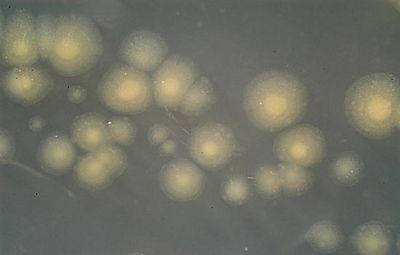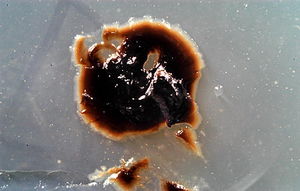Roseobacter
A Microbial Biorealm page on the genus Roseobacter

Classification
Higher order taxa:
Bacteria, Proteobacteria, Alphaproteobacteria, Rhodobacterales, Rhodobacteraceae
Species:
Roseobacter denitrificans; R. gallaeciensis; R. litoralis; R. pelophilus; R. prionitis; R. sp.
|
NCBI: Taxonomy Genome: R. denitrificans R. sp. MED193 |
Description and Significance
Roseobacters were first described in 1991 with the discovery of Resobacter litoralis and Roseobacter denitrificans. Both of these were pink-pigmented bacterialchlorophyll strains from marine algae. Since this time it has been found that 17 genera are represented with 36 species and many more un-characterized isolates.
Roseobacters have been found to play a large part in marine biogeochemical cycles and in climate change and are well-known for processing a large amount of marine carbon. They make up approximately 25% of coastal marine bacteria and they are represented across many diverse habitats including coastal, open oceans, sea ice and sea floor.
Genome Structure
Currently two species of Roseobacter are being sequenced: R. denitrificans (Arizona State University) and R. sp. MED193 (Gordon and Betty Moore Foundation). The sample of R. sp. MED193 being sequenced was collected one meter down in the waters of the Northwest Mediterranean Sea. According to Boettcher et. al., the principal fatty acid in whole cells is C(18:1)omega7c and other characteristic fatty acids are C(16:0), C(10:0) 3-OH, 11-methyl C(18:1)omega7c and C(18:0). In addition, nearly without exception, all isolates have 16S rRNA gene sequences that are identical (Boettcher et. al.). While little is currently known about these strains, there is promising knowledge ahead as the sequencing continues.
Cell Structure and Metabolism

The Gram-negative Roseobacter species have been identified as both oval and rod-like shaped cells with either one or two flagella present, making them fully mobile. Their size can range from 4.3 kilobases to 821.7 kilobases. They have a have a mesophilic temperature range, are heterotrophs and anaerobic (as they are a marine species).
Roseobacter can have major implications for turnover of organic material in the ocean as they consume decomposing organisms, also known as marine snow (phytoplankton or organic "aggregates". They freely swim throughout the water until they find a particle to colonize.
It has been suggested that Roseobacter bacteria benefit from association with dimethylsulfoniopropionate (DMSP)-producing dinoflagellates because of the high metabolic rate at which Roseobacter can degrade them. The result of such associating is the use of both lyase and demethylation pathways (Miller).
Ecology
Roseobacter strains have been found in a variety of places including the Mediterranean and New England. One of the most striking feature of Roseobacter is the exceptional amount of variation between the strains in the different locations in which Roseobacter has been identified. One potential cause for concern is the number of unconfirmed strains that have been identified as of the Roseobacter species, which could lead to incorrect information if wrongly indentified.
Pathology
A strain of Roseobacter(deemed R. crassotreae) has been identified as an oyster pathogen leading to a disease called Juvenile Oyster Disease (JOD), severely affecting oysters in New England. What is most concerning about this recent increased mortality rate is the discovery of Roseobacter strains in apparently healthy oysters up a week prior to the outbreaks. Roseobacter has been affecting oysters older than two years (Boettcher).
